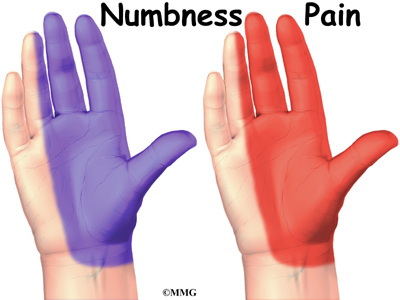Carpal tunnel syndrome is a syndrome (a group of symptoms) resulting from compression (pinching) of the median nerve, one of the main nerves that extends through the arm and to the hand. It takes its name from the carpal tunnel, the part of the wrist nearest to the palm of the hand. The symptoms of carpal tunnel syndrome can include pain, numbness, and “pins and needles” sensations. It most often affects the thumb, index finger, and middle finger, but any part of the hand, wrist, or forearm can be affected. Symptoms are often most noticeable at night, especially in the hand on the side of the body that is closest to the bed when the patient is sleeping on his or her side.

The following are risk factors for developing carpal tunnel syndrome:
- Acromegaly (a hormonal imbalance characterized by excess of growth hormone)
- Amyloidosis (abnormal protein synthesis in the body, leading to hyperpigmentation of the skin and disorders of various organs)
- Benign soft tissue tumors, such as ganglion (a nerve tissue tumor) or lipoma (an adipose tissue tumor)
- Diabetes
- Double crush syndrome (compression of nerves that lead to the median nerve; this diagnosis is controversial)
- Genetic factors, including mutations of the gene SH3TC2
- Hypothyroidism
- Obesity
- Pregnancy
- Manual work including repetitive motions, such as cooking, sewing, typing, or operating vibrating instruments like drills
- Rheumatoid arthritis
- Traumatic injuries
Because it is associated with repetitive movements of the hand, middle-aged people who have performed manual labor for many years are disproportionately represented among carpal tunnel syndrome patients. Since obesity is a risk factor, people with a body mass index over 25 are also disproportionately represented. Mild cases of carpal tunnel syndrome are often treated simply by the patient wearing a wrist splint or other type of wrist brace or taking over-the-counter anti-inflammatory drugs such as ibuprofen. Corticosteroids administered by injection are indicated for moderate cases. Carpal tunnel syndrome tends to be progressive, meaning that it gets worse over time, so that these remedies offer less and less relief. Severe cases of carpal tunnel syndrome are treated with surgery to relieve the compression of the median nerve. Various physical therapy treatments have also been indicated for relief of carpal tunnel syndrome symptoms.
If the carpal tunnel syndrome has an underlying medical cause such as diabetes or a hormonal imbalance, it is important to treat the underlying cause in addition to treating the carpal tunnel syndrome. If you have been diagnosed with diabetes, it is important to have regular visits to a diabetes specialist and to monitor your blood sugar; simply treating the most noticeable symptoms of diabetes is not enough to prevent serious illness.
Chiropractic Treatment for Carpal Tunnel Syndrome
Chiropractic is not only for treatment of back pain. It is an entire system of alternative medicine that has applications in the treatment of a wide variety of conditions, including carpal tunnel syndrome. Chiropractors ascribe to the theory that all medical conditions are related to the nervous system and that manipulation of the spine, joints, and soft tissues can affect the nervous system. Chiropractic treatment involving manipulation of the joints in the arm and wrist has been shown to relieve symptoms of carpal tunnel syndrome in some patients. Chiropractors may also recommend other treatments that do not involve medication or surgery. These treatments can include exercises that build strength or flexibility, including yoga exercises. The chiropractor may also mobilize the soft tissues of the hand and wrist. Ask your chiropractor if chiropractic treatment can help with your carpal tunnel syndrome symptoms.








:max_bytes(150000):strip_icc()/RareBeauty-Perfect-Strokes-Mascara-JESSICAJULIAO-0586.jpg-2aaec77adfe9485ea576f551d0a429f9.jpg)




